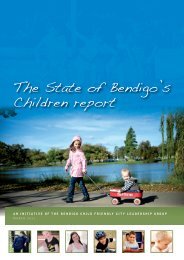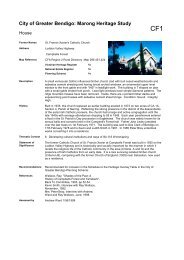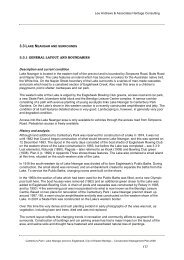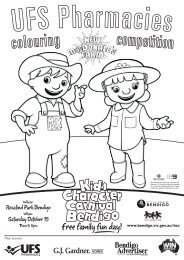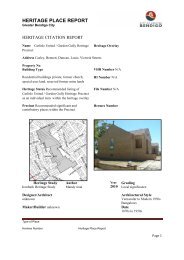HYGIENE GUIDELINES - City of Greater Bendigo
HYGIENE GUIDELINES - City of Greater Bendigo
HYGIENE GUIDELINES - City of Greater Bendigo
Create successful ePaper yourself
Turn your PDF publications into a flip-book with our unique Google optimized e-Paper software.
<strong>HYGIENE</strong> <strong>GUIDELINES</strong><br />
Quality Area 2<br />
PURPOSE<br />
To provide a set <strong>of</strong> procedures to ensure an environment that is safe, clean, hygienic, and controls the<br />
spread <strong>of</strong> infection<br />
OBJECTIVES<br />
To implement infection control procedures to minimise the likelihood <strong>of</strong> cross-infection and the<br />
spread <strong>of</strong> infectious diseases and illnesses to children, educators and any other persons in<br />
attendance at the service<br />
To fulfil the service’s duty <strong>of</strong> care requirement under the Occupational Health and Safety Act 2004,<br />
the Education and Care Services National Law Act 2010 and the Education and Care Services<br />
National Regulations 2011 to ensure that those involved with the service are protected from harm.<br />
SCOPE<br />
These guidelines apply to the Approved Provider, Nominated/Certified Supervisors, Early Childhood<br />
Educators, students on placement, parents/guardians, children and others attending the programs and<br />
activities at <strong>City</strong> <strong>of</strong> <strong>Greater</strong> <strong>Bendigo</strong> Early Learning Services, including <strong>of</strong>fsite excursions and<br />
activities.<br />
DEFINITIONS<br />
Communicable disease: A disease that can be transmitted from one infected person to another,<br />
either directly or indirectly.<br />
Infectious disease: A disease that can be spread, from person to person, through coughing,<br />
sneezing or contact.<br />
PROCEDURES<br />
The Approved Provider is responsible for:<br />
Ensuring the Nominated Supervisor, educators at the service implement adequate health and<br />
hygiene practices including safe food handling<br />
Arranging for the service to be cleaned on a regular basis as per the cleaning contract and schedule<br />
Reviewing educator’s training needs in relation to understanding and implementing effective<br />
hygiene practices in Education and Care Services.<br />
The Nominated Supervisor/ Certified Supervisor is responsible for:<br />
Implementing and ensuring that all educators at the service follow health, hygiene and safety<br />
practices to minimise risks to children and educators<br />
Actively encouraging parents/guardians to keep children who are unwell at home to prevent the<br />
spread <strong>of</strong> infection to other children and educators<br />
Ensuring that there is a regular and thorough cleaning and disinfecting schedule for all equipment<br />
and toys<br />
Developing an effective cleaning schedule that outlines daily, weekly, monthly, quarterly and annual<br />
cleaning and sanitising requirements and responsibilities<br />
Ensuring that specific procedures are displayed in appropriate areas for toileting, changing <strong>of</strong><br />
nappies and hand washing<br />
Ensuring that laundry facilities are available and in good working order for dealing with soiled<br />
clothing and linen.<br />
Hygiene <strong>GUIDELINES</strong><br />
Page 1 <strong>of</strong> 4
Early Childhood Educators are responsible for:<br />
Implementing and promoting correct hand washing and hygiene practices<br />
Maintaining the service in a clean and hygienic manner throughout the day<br />
Ensuring they wear disposable gloves when changing soiled nappies, dealing with open wounds or<br />
other body fluids, and dispose <strong>of</strong> those gloves and soiled materials in a sealed container or plastic<br />
bag<br />
Ensuring that an inspection <strong>of</strong> the outdoor areas, in particular the sand and s<strong>of</strong>t-fall areas, are<br />
conducted each morning to ensure they are maintained in a safe and hygienic manner<br />
Storing or presenting items, such as beds, bedding and sunhats, in such a way as to prevent<br />
cross-contamination<br />
Being conscious <strong>of</strong> their responsibility to stay away from the service when they have or suspect<br />
they have an infectious disease.<br />
In terms <strong>of</strong> changing nappies for children, educators are responsible for:<br />
Attending to the individual personal hygiene needs <strong>of</strong> each child as soon as is practicable<br />
Changing nappies and attending to individual personal hygiene and toileting needs <strong>of</strong> each child<br />
according to recommended procedures<br />
Disposing <strong>of</strong> soiled nappies in a safe and hygienic manner.<br />
In terms <strong>of</strong> the toileting <strong>of</strong> children, educators are responsible for:<br />
Respecting the need to maintain privacy <strong>of</strong> toileting and dressing<br />
Encouraging children to flush the toilet after use<br />
Respecting diverse styles <strong>of</strong> toileting children due to cultural or religious practices<br />
Encouraging children to tell an educator if they have had a toileting accident<br />
Encouraging and assisting children to wash their hands according to hand washing guidelines (refer<br />
to Attachment 1) after toileting<br />
Ensuring soap and drying facilities are available at all times<br />
Ensuring children do not share the use <strong>of</strong> items related to personal care, such as hand towels for<br />
drying hands, toothbrushes and hairbrushes.<br />
In terms <strong>of</strong> children’s bedding, educators are responsible for:<br />
Ensuring that rooms used for sleep and relaxation are well ventilated<br />
Providing clean linen, blanket and mattress protector for each child<br />
Cleaning bedding (mats and cots) after use by each child when children share bedding equipment<br />
throughout the week<br />
Washing linen after use by each child when children share bedding throughout the week, or<br />
changing every 5 days when used only by the one child<br />
Storing separately for each child, bedding to be used again by the same child and labelling with<br />
their name to prevent cross-contamination.<br />
For cleaning toys, clothing and the service in general, educators are responsible for:<br />
Wearing gloves when cleaning<br />
Washing mouthed toys daily using warm water and detergent and, if possible, drying in the sun.<br />
Alternatively, and if suitable, mouthed toys may be washed in a commercial dishwasher and<br />
allowed to air dry<br />
Ensuring washable toys and equipment are cleaned term by term or as required.<br />
In regard to children’s contact with one another, educators are responsible for:<br />
Educating and encouraging children in good personal hygiene practices, such as:<br />
Washing their hands after toileting<br />
Washing their hands after blowing and wiping their nose<br />
Hygiene <strong>GUIDELINES</strong><br />
Page 2 <strong>of</strong> 4
(If unable to wash hands using soap and water, using antibacterial sanitiser)<br />
Disposing <strong>of</strong> used tissues promptly and appropriately<br />
Only touching the food they are going to eat<br />
Not touching one another when they are cut or bleeding<br />
Using their own equipment for personal care, such as toothbrushes, hats, brushes and combs<br />
Using own drink bottles or cups.<br />
For the Indoor and Outdoor environments, educators are responsible for:<br />
Keeping the indoor and outdoor environments as clean and hygienic as possible at all times,<br />
including the safe disposal <strong>of</strong> discarded needles/syringes/sharps<br />
Promptly removing blood, urine and faeces (including animal) either indoors or outdoors, using the<br />
appropriate cleaning procedures<br />
Emptying water containers, such as water trays, each day.<br />
Safe handling <strong>of</strong> body fluids or materials in contact with body fluids:<br />
Avoid direct contact with blood or other fluids<br />
Do not be at eye level when cleaning/treating a child’s face that has blood on it, as a child’s blood<br />
can enter the mouth/nose <strong>of</strong> an educators when a child cries or coughs<br />
Wear gloves<br />
Cover any cuts/abrasions on their own hands with a waterpro<strong>of</strong> dressing<br />
Any products contaminated with blood are placed in a double plastic bag and disposed straight into<br />
rubbish bins<br />
Washing hands immediately after handling <strong>of</strong> body fluids or materials contaminated with body fluids.<br />
Effective environmental cleaning:<br />
Toilets/sinks must be cleaned daily (during rest time or as required as spills occur,) and separate<br />
cleaning cloths/sponges must be used for each task. These areas are to be cleaned with<br />
antibacterial wipes or antibacterial spray and paper towel)<br />
Nappy change areas/mats must be wiped with antibacterial wipes after each nappy change<br />
All bench tops and floors must be cleaned daily or as required as spills occur<br />
Children’s cups/drink bottles used for water must be washed after use<br />
Tea towels to be changed daily<br />
When doing the laundry, educators are to consider washing items separately to minimise crosscontamination<br />
including washing bibs and face washers separate to other items.<br />
Parents/guardians are responsible for:<br />
Keeping their child/ren home if they are unwell or have an infectious disease that requires their<br />
exclusion from the Education and Care Service<br />
Informing the service if their child has an infectious disease<br />
Supporting this Service by complying with the hygiene practices when attending the service or when<br />
assisting with a service program or activity<br />
Encouraging their child/ren to develop and follow effective hygiene practices at all times.<br />
EVALUATION<br />
These guidelines will be revised on an annual basis or as required following any incident related to the<br />
guidelines in accordance with current legislation, research and policy.<br />
SOURCES<br />
www.kpv.org.au<br />
RELATED <strong>GUIDELINES</strong><br />
Dealing with Medical Conditions<br />
Dealing with Infectious Diseases<br />
Hygiene <strong>GUIDELINES</strong><br />
Page 3 <strong>of</strong> 4
Occupational Health and Safety<br />
<strong>GUIDELINES</strong> DEVELOPED<br />
September 2012<br />
REVIEW DATE<br />
September 2013<br />
Hygiene <strong>GUIDELINES</strong><br />
Page 4 <strong>of</strong> 4




